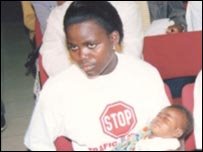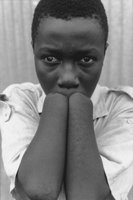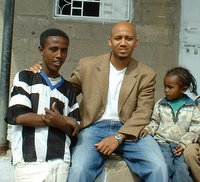Saturday, April 22, 2006
Ethiopia's orphans mounting up due to HIV/AIDS
VIA: People's Daily Online
Full Article Below:
Ethiopia's orphans mounting up due to HIV/AIDS
The number of orphans in Ethiopia is rising in an alarming rate due to the HIV/AIDS pandemic, a senior government official said Sunday.
Mohammed Mealin Ali, state minister of labor and social affairs, told a nationwide conference that many children, who lost their parents due to HIV/AIDS, are facing social, economic and psychological challenges.
He said finding sustainable solutions for the problem demands commitment and participation of all concerned bodies. The number of orphans is currently estimated to be over 4 million in
Ethiopia with a population of nearly 70 million, he added.
The Ethiopian official alarmed a quarter of Ethiopian children may loose their parents due to the HIV/AIDS pandemic over the next five years. According to government statistics, some 1.5 million Ethiopians are infected with HIV, the virus that causes AIDS, while close to a million children have been orphaned by the disease. About 5,000 new infections are recorded weekly.
Full Article Below:
Ethiopia's orphans mounting up due to HIV/AIDS
The number of orphans in Ethiopia is rising in an alarming rate due to the HIV/AIDS pandemic, a senior government official said Sunday.
Mohammed Mealin Ali, state minister of labor and social affairs, told a nationwide conference that many children, who lost their parents due to HIV/AIDS, are facing social, economic and psychological challenges.
He said finding sustainable solutions for the problem demands commitment and participation of all concerned bodies. The number of orphans is currently estimated to be over 4 million in
Ethiopia with a population of nearly 70 million, he added.
The Ethiopian official alarmed a quarter of Ethiopian children may loose their parents due to the HIV/AIDS pandemic over the next five years. According to government statistics, some 1.5 million Ethiopians are infected with HIV, the virus that causes AIDS, while close to a million children have been orphaned by the disease. About 5,000 new infections are recorded weekly.
Monday, April 17, 2006
Horror of India's child sacrifice
 VIA: BBC
VIA: BBCEXCERPTS FROM ARTICLE: Horror of India’s Child Sacrifice
In India's remote northern villages it feels as if little has changed. The communities remain forgotten and woefully undeveloped, with low literacy and abject poverty.
They are conditions that for decades have bred superstition and a deep-rooted belief in the occult.
The village of Barha in the state of Uttar Pradesh is only a three-hour car drive from the capital Delhi. Yet here evil medieval practices have made their ugly presence known.
Lured with sweets I was led by locals to a house that is kept under lock and key. They refuse to enter it. Peering through the window bars you can see the eerie dark room inside, with peeling posters of Hindu gods adorning the walls and bundles of discarded bedclothes. In one corner is the evidence we had come to find: blood-splattered walls and stained bricks.
It is the place where a little boy's life was ritually sacrificed. Those who tortured and killed Akash Singh did so in a depraved belief - that the boy's death would offer them a better life.
"The woman who did this was crazed," the villagers say. "Akash was friends with all our children... We still cannot believe what happened here."
Akash's distraught mother discovered her son's mutilated body. The family was told he was lured away with sweets and begged his captors to set him free.
"First they cut out his tongue," his grandmother Harpyari told me. "Then they cut off his nose, then his ears. They chopped off his fingers. They killed him slowly."
'Profiting from fear'
The woman who abducted Akash lived just a few doors away. She claimed to be suffering from terrible nightmares and visions.
It was then she turned for guidance to a tantric, or holy man. It was under his instruction that she brutally sacrificed the boy - offering his blood and remains to the Hindu goddess of destruction.
There are temples across India that are devoted to the goddess. Childless couples, the impoverished and sick visit to pray that she can cure them.
Animal sacrifice is central to worship - but humans have not been temple victims since ancient times.
Crackdown campaign
S Raju is a journalist for the Hindustan Times and has been reporting on child sacrifice cases since 1997 in western Uttar Pradesh. He has reported on 38 similar cases.
In one incident he says a tantric told a young man that if he hanged and killed a small boy and lit a fire at his feet the smoke from the ritual could be used to lure the pretty village girl he had his eye on.
Unreported
We visited the jail where those accused of murdering Akash were being held. The prison warden told us of over 200 cases of child sacrifice in these parts over the last seven years. He admitted many of the cases go unreported because the police are reluctant to tarnish the image of their state. He told us incidents of child sacrifice are often covered up. Many of those killers are behind bars - but, chillingly, others poisoned by the same sinister beliefs remain at large.
PREVENTION: 45 million new HIV cases projected to occur worldwide between 2002 and 2010
VIA:AlerNet
EXCERPTS FROM ARTICLE: Africa launches push to prevent new HIV cases
JOHANNESBURG, April 11 (Reuters) - African leaders have launched a drive to halt new HIV infections, saying prevention may be the best remaining hope to stop the AIDS pandemic from cutting an ever-deeper swathe across the continent.
The African Union (AU) said programmes on education, counseling, testing and condom distribution could stop 29 million of the 45 million new HIV cases projected to occur worldwide between 2002 and 2010.
While global attention has focused on bringing HIV treatment, including anti-retroviral (ARV) drugs, to help Africa combat the world's worst AIDS crisis, new HIV infections continue unabated across much of the continent.
In 2005, 3.2 million of the five million new HIV infections recorded globally occurred in sub-Saharan Africa -- a region struggling with some 26 million HIV-positive people and mourning at least 22 million killed by the disease since the 1980s.
The initiative follows the failure of the U.N.'s "3 by 5" programme which had hoped to put three million people in the developing world on ARVs by the end of 2005.
While officials said progress was made in broadening access to treatment, only about 1.3 million people were receiving the drugs by the end of the target period.
EMPHASIZE PREVENTION
South Africa dropped its official objections to ARVs in 2003 and now has one of the world's largest ARV programmes -- albeit one that reaches only about 100,000 people, or half the number of South Africans AIDS kills every year. The government meanwhile continues to promote a grassroots response to the epidemic with the emphasis on basic health care, nutrition, abstinence programmes and condom distribution.
The new AU initiative reflects many of these priorities, highlighting the need to both educate people about the virus and provide more testing to stop new transmissions.
To illustrate the need, UNICEF said that every day, nearly 2,000 infants are infected with HIV during pregnancy, childbirth or breastfeeding and 6,000 young people between the ages of 15 and 24 contract the virus -- most of them in Africa.
EXCERPTS FROM ARTICLE: Africa launches push to prevent new HIV cases
JOHANNESBURG, April 11 (Reuters) - African leaders have launched a drive to halt new HIV infections, saying prevention may be the best remaining hope to stop the AIDS pandemic from cutting an ever-deeper swathe across the continent.
The African Union (AU) said programmes on education, counseling, testing and condom distribution could stop 29 million of the 45 million new HIV cases projected to occur worldwide between 2002 and 2010.
While global attention has focused on bringing HIV treatment, including anti-retroviral (ARV) drugs, to help Africa combat the world's worst AIDS crisis, new HIV infections continue unabated across much of the continent.
In 2005, 3.2 million of the five million new HIV infections recorded globally occurred in sub-Saharan Africa -- a region struggling with some 26 million HIV-positive people and mourning at least 22 million killed by the disease since the 1980s.
The initiative follows the failure of the U.N.'s "3 by 5" programme which had hoped to put three million people in the developing world on ARVs by the end of 2005.
While officials said progress was made in broadening access to treatment, only about 1.3 million people were receiving the drugs by the end of the target period.
EMPHASIZE PREVENTION
South Africa dropped its official objections to ARVs in 2003 and now has one of the world's largest ARV programmes -- albeit one that reaches only about 100,000 people, or half the number of South Africans AIDS kills every year. The government meanwhile continues to promote a grassroots response to the epidemic with the emphasis on basic health care, nutrition, abstinence programmes and condom distribution.
The new AU initiative reflects many of these priorities, highlighting the need to both educate people about the virus and provide more testing to stop new transmissions.
To illustrate the need, UNICEF said that every day, nearly 2,000 infants are infected with HIV during pregnancy, childbirth or breastfeeding and 6,000 young people between the ages of 15 and 24 contract the virus -- most of them in Africa.
Saturday, April 08, 2006
A LIFE ENDED BY CHILD TRAFFICKERS
 By:Nasir Al-Amin
By:Nasir Al-AminThe following is an excerpt from a BBC article that details the experience of one of the 1.2 million children trafficked each year. Fueled by poverty, trafficking is a lucrative global problem and is considered to be the fastest growing crime grossing an estimated $10 billion annually. Families and children are lured into trafficking by the promise of money and “a better life,” thus poor families and children need to be afforded viable alternatives, which could include practical skills training or income-generating schemes.
* Excerpt from Article below:
A Life Ended By Child Traffickers
Via: BBC
Mounriatou was just 16 when she was taken from her home in Togo to the oil-rich state of Gabon. Less than a year later she was dead from Aids after being gang-raped by a group of boatmen on her way to the "promised land". Just before she died she told aid workers her story. Now the charity, Plan International, is fighting to stop child trafficking and keep children like Mounriatou safe in their own countries.
Poverty pay
Mounriatou's family were in dire financial straits. She had been forced to drop out of school to help her mother make a living frying bean nuts. One day a woman came to their village to see her mother and told of a life of riches in the Gabon. Mounriatou decided to go with her to seek her fortune and left without telling her mother. She was taken with four other women to the capital of Togo, Lome, and from there to Lagos, in Nigeria.
While waiting to move on from Lagos, Mounriatou had to work as a maid to survive. She worked for just 55 US cents a day and when Adama, the woman who had recruited her and the other women, returned she took all their earnings. By now she had a collected a group of 14 girls and moved them to a village in the southwest of Nigeria. She promised they would soon be heading for the Gabon, but for months they were forced to work to pay for their trip with street traders - and were raped nightly by the canoe men. Mounriatou told charity workers: "Finally, we were told one night that we were leaving by sea early the following morning at dawn.
"There were between 300 and 350 clandestine passengers and children were in the majority.” We spent five days on high seas trying to hide from the coastguards. "This made some of us sick and the canoe men got rid of those who were very ill by throwing them into the sea." Mounriatou was ill, but she managed to survive.
Pregnant
But when she reached the shore it became obvious that she was heavily pregnant and of no use to her 'mistress'. "I was six months pregnant due to the numerous sexual abuses meted on us by the canoe men to pay for our trip to the Gabon." Adama dumped her with just $18. She was taken to the Togo Embassy and left with the Catholic sisters until she gave birth. When she gave birth, both she and her child had Aids. The Togo Embassy helped her to return home and within nine months both she and her child were dead.
Tuesday, April 04, 2006
INVISIBLE CHILDREN: ROUGH CUT (Documentary)
 By: Nasir Al-Amin
By: Nasir Al-Amin Daily vulnerable children confront inconceivable obstacles that challenge their right to a childhood saturated with peace, security and nurturing experiences. One such obstacle is armed conflict, which turns vulnerable children into Child Soldiers: “instruments of war, to kill or be killed.” According to United Nations estimates, approximately 300,000 children are currently engaged in conflicts around the world. This figure does not comprise of the number of children engaged in combat training or laborious activities associated with combat, which then exacerbates the number into hundreds of thousands—more than 300,000. The sexual, physical and emotional abuse associated with war imprints a devastating mark on a child’s physical, psychological, and intellectual development.
The documentary Invisible Children: Rough Cut explores the experience of children exploited for combat. The documentary is on a nation wide tour, so in order to find a screening date and venue near you go to the following link: http://invisiblechildren.com/theMovie/screenings/
What follows is the Movie Synopsis from Invisible Children (www.invisiblechildren.com/media/pdfs/
movie_synopsis.pdf)
Invisible Children: Rough Cut
Movie Synopsis:
What started out as a film-making adventure in Africa, transformed into much more, when the three young American’s (Jason Russell, Bobby Bailey, and Laren Poole) original travels took a divine turn, and they found themselves stranded in Northern Uganda. They discovered children being kidnapped nightly from their homes and subsequently forced to fight as child soldiers. This film is dedicated to exposing this tragic, and amazingly untold story.
Even at this moment, in Uganda, Children as young as 8 are methodically kidnapped from their homes by a rebel group called the “Lord’s Resistance Army” (LRA). The abducted children are then desensitized to the horror of brutal violence and killing, as they themselves are turned into vicious fighters. Some escape and hide in constant fear for their lives.
Most remain captive, and grow to maturity with no education other than life “in the bush” and fighting in a guerilla war. Of the many ramifications that a 20 -year-long war can cause, the .lm “Invisible Children: Rough Cut” highlights what the community refers to as “NIGHT COMMUTERS.” We watch thousands of children “commute” out of fear, from their villages to nearby towns each night in order to avoid the LRA (Lord’s Resistance Army) abductions. They sleep in public places, vulnerable, and without supervision.
This film focuses in on 4 young boys: Jacob, Thomas, Tony, and Boni. Through their eyes, we relive the terror of abduction, courage of survival, the heartbreak of losing a brother, and the innate joy- found only in a child. The three filmmakers (Jason, Bobby, and Laren) were amazed to and many things in common between these kids and kids in
America, themselves included. As the three left Northern Uganda, they were appalled by what they had seen, and yet, in awe of the resilience and hope they found in these children, and this community. The filmmakers thought: How could such an atrocity exist for such a long time, without the world knowing?
Believing that the “invisible children’s” story could inspire others to do something, as it did them, they created a documentary, which we now know as the “Invisible Children: Rough Cut”. They originally screened the film in June 2004 for friends and family and soon expanded to high schools, colleges, and organizations. After audiences viewed the movie, one question repeatedly surfaced, “what can we do?” And so, a nonprofit was birthed out of a film.
Additionally, for those in New York here are two upcoming dates and locations:
On April 18, 2006, 6:30 PM @ 75 Third Ave. at E. 11th St. (Mini Theater). RSVP required at hrwya_advocacy@yahoo.com
On April 19, 2006, 6:15 PM @ Columbia University School of Social Work, 1255 Amsterdam Ave., Room C03. RSVP required at hrwya_advocacy@yahoo.com
COMMUNITY DAY

I want to give my sincere appreciation to the Columbia University’s International Social Welfare Caucus for inviting me to Columbia in order to speak about Orphans and Vulnerable Children (OVC) in Ethiopia. I hope that I was able to convey the plight of ovc as well as the challenges and opportunities present to affect change.
Sincerely,
Nasir Al-Amin
Subscribe to:
Posts (Atom)

